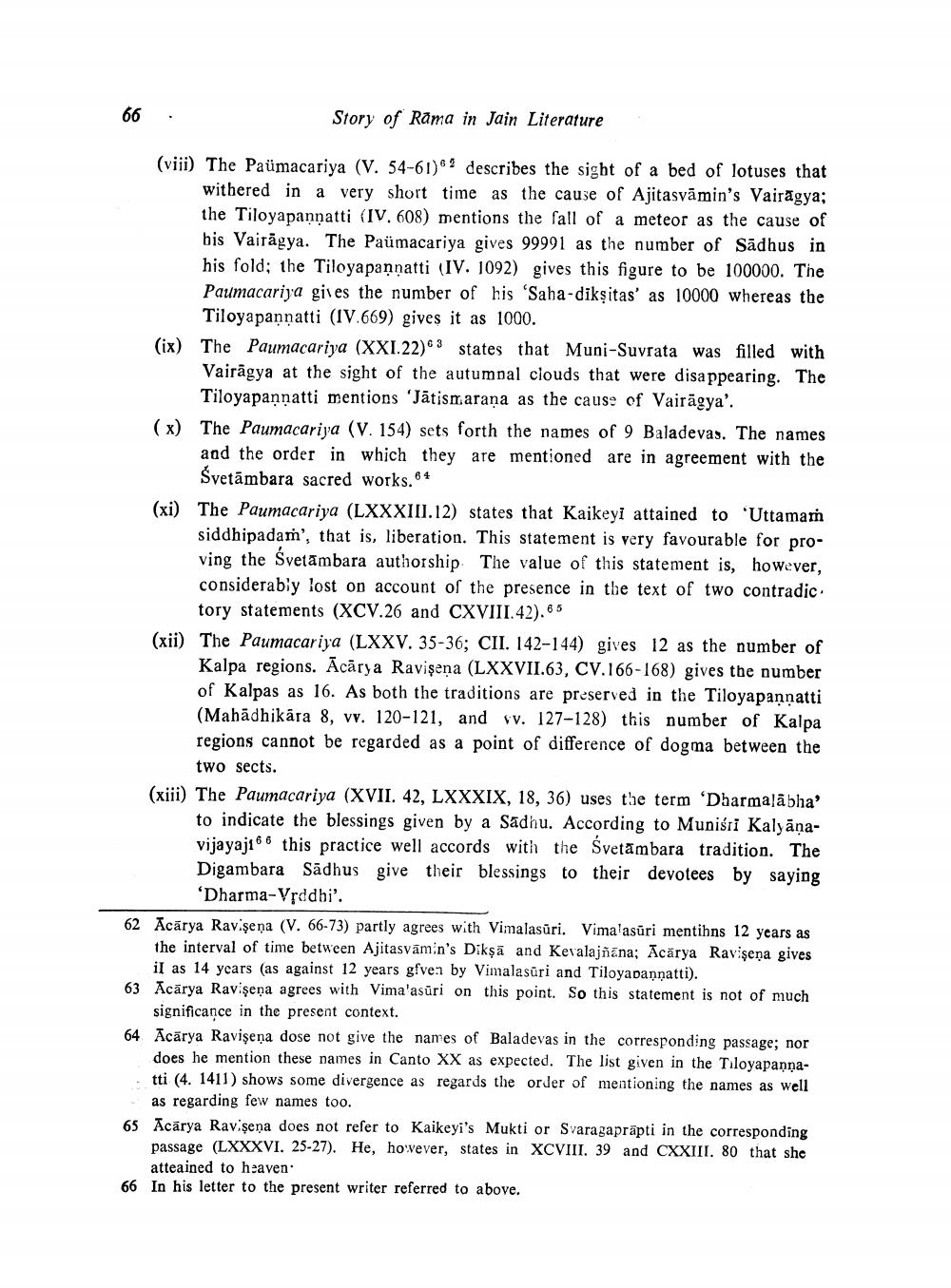________________
66
Story of Rama in Jain Literature
(viii) The Paumacariya (V. 54-61)
describes the sight of a bed of lotuses that withered in a very short time as the cause of Ajitasvamin's Vairagya; the Tiloyapanṇatti (IV. 608) mentions the fall of a meteor as the cause of bis Vairagya. The Paümacariya gives 99991 as the number of Sådhus in his fold; the Tiloyapanṇatti (IV. 1092) gives this figure to be 100000. The Paumacariya gives the number of his 'Saha-diksitas' as 10000 whereas the Tiloyapanpatti (IV.669) gives it as 1000.
(ix) The Paumacariya (XXI.22)63 states that Muni-Suvrata was filled with Vairagya at the sight of the autumnal clouds that were disappearing. The Tiloyapannatti mentions 'Jätismarana as the cause of Vairagya'.
(x) The Paumacariya (V. 154) sets forth the names of 9 Baladevas. The names and the order in which they are mentioned are in agreement with the Svetämbara sacred works."
(xi) The Paumacariya (LXXXIII.12) states that Kaikeyi attained to Uttamarh siddhipadam', that is, liberation. This statement is very favourable for proving the Svetambara authorship The value of this statement is, however, considerably lost on account of the presence in the text of two contradic tory statements (XCV.26 and CXVIII.42).65
(xii) The Paumacariya (LXXV. 35-36; CII. 142-144) gives 12 as the number of Kalpa regions. Acarya Ravisena (LXXVII.63, CV.166-168) gives the number of Kalpas as 16. As both the traditions are preserved in the Tiloyapanṇatti (Mahadhikara 8, vv. 120-121, and vv. 127-128) this number of Kalpa regions cannot be regarded as a point of difference of dogma between the
two sects.
(xiii) The Paumacariya (XVII. 42, LXXXIX, 18, 36) uses the term 'Dharmalabha' to indicate the blessings given by a Sadhu. According to Munis Kalyanavijayaj this practice well accords with the Svetambara tradition. The Digambara Sadhus give their blessings to their devotees by saying 'Dharma-Vrddhi'.
62 Acarya Ravişena (V. 66-73) partly agrees with Vimalasūri. Vimalasuri mentihns 12 years as the interval of time between Ajitasvamin's Dikṣā and Kevalajñāna; Acarya Ravişeņa gives il as 14 years (as against 12 years gfven by Vimalasuri and TiloyaDannatti).
63 Acarya Ravişena agrees with Vima'asuri on this point. So this statement is not of much significance in the present context.
64 Acarya Ravişena dose not give the names of Baladevas in the corresponding passage; nor does he mention these names in Canto XX as expected. The list given in the Tiloyapanṇatti (4. 1411) shows some divergence as regards the order of mentioning the names as well as regarding few names too.
65 Acarya Ravişena does not refer to Kaikeyi's Mukti or Svaragaprapti in the corresponding passage (LXXXVI. 25-27). He, however, states in XCVIII. 39 and CXXIII. 80 that she atteained to heaven
66 In his letter to the present writer referred to above.




